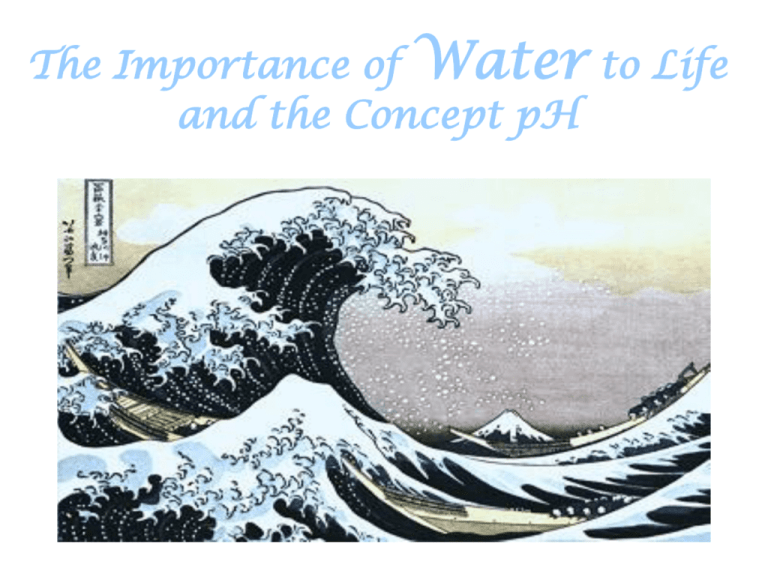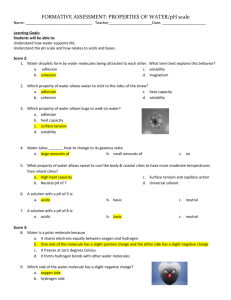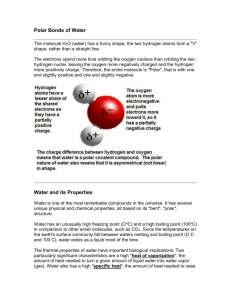Water
advertisement

The Importance of Water to Life and the Concept pH Earth’s Environmental Conditions that Sustain Life are Dependent on Water • Over 75% of the Earth’s surface is covered by water in one form or another. • Earth’s climate is intrinsically tied to water and its properties. Earth’s Living Organisms Contain a High Volume of Water • All life needs water in one way or another for survival. • All living organisms contain a high volume of water in their cells, tissues, and body. Water Is a Polar Molecule • In a water molecule, Oxygen holds the electrons that it covalently shares with the two Hydrogen closer to its nucleus. • Therefore, in water, Oxygen picks up two negative charges and each Hydrogen has one positive charge. Water’s Polarity Leads to Hydrogen Bonding • Hydrogen bonding amongst water molecules give water its properties as a substance. • Water molecules are held together by hydrogen bonds to make water a very “solid-like” liquid. Unique Properties of Water Sustain Life Cohesion/ Adhesion Surface Tension Specific Heat Density Solvent Attraction of water molecules for each other and other substances, respectively. Ex. H2O drops Water has a film-like surface due to the cohesion of the molecules at the surface. Water absorbs and stores a large amount of heat, then releases it slowly. Water is less dense as a solid and more dense as a liquid, therefore, ice floats. Water is a universal, most versatile, solvent. Cohesion and Adhesion • Cohesion – attraction that water molecules have for each other, due to Hydrogen bonds. • Adhesion – attraction that polar molecules have for molecules of other substances. • Cohesion-tension transports a H2O column from roots to leaves. Water Moderates Temperature • As H2O is heated Hydrogen bonds break and reform, therefore, a large amount of heat is absorbed and stored with a minimal change in temperature. • As water cools, hydrogen bonds form and absorb energy in the process, therefore, slowing the cooling time. • Water slows “moderates” temperature changes. Water is Less Dense as a Solid Than as a Liquid: Ice Floats! • Frozen water is a crystal, where each H2O molecule is rigidly Hydrogen bonded to four other water molecules. At cold temperatures, there is insufficient energy to continuously break and form Hydrogen bonds. This arrangement creates free space between the molecules, i.e. less density. • In liquid water there is plenty of energy to cause the constant breakage and reforming of Hydrogen bonds. Therefore, the H2O molecules rotate freely and are closer in proximity, than in cool conditions, i.e. more dense. Water a Most Versatile Solvent • Solutions are made up of solvents and solutes. • Due to its polar nature, in living things, water is the most versatile solvent. • Water dissolves both ionic and polar substances by creating spheres of hydration around the solutes. • Hydrophilic substances easily dissolve in water. Water Dissociates Into H+ and OH• In solutions, water molecules split into OH(Hydroxide ions) and H+ (Hydrogen ions). • OH- and H+ ions are very reactive and must be balanced. Neutral solutions have similar amounts of OH- and H+ • Buffers balance solutions. • Acids donate H+ ions to the solution. • Bases accept H+ ions from the solution. • pH is the negative log (base 10) of the Hydrogen ion concentration in a solution. • The pH scale ranges from 0, most acidic (most H+); to 14, least acidic (most OH-) or most basic; with 7 being neutral, (H+ = OH-). • Buffers moderate pH Optimal Ranges to Maintain Homeostatic Balance • In order to maintain a stable and healthy internal environment to allow life’s functions, organisms must exist in optimum ranges or conditions. • pH ranges that are too acid or basic may harm an organism, • Ex. Acidification of trees due to acid precipitation.










